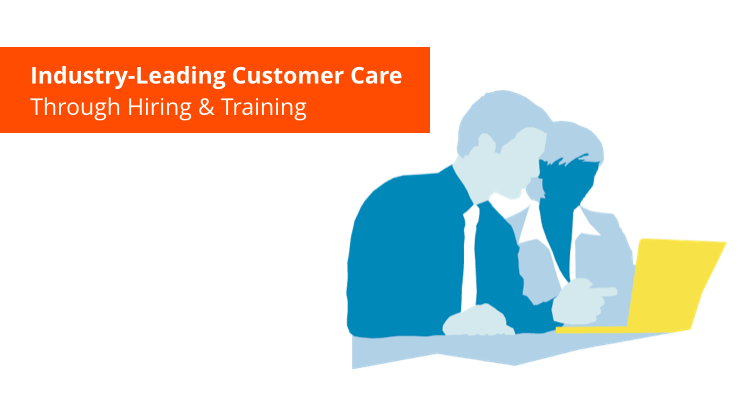How To Achieve Industry-Leading Customer Care Through Hiring & Training
In our sessions with clients, and with prospective clients, the question inevitably comes up.
How can you promise such high satisfaction scores, first-touch resolution rates, and customer service cost reductions?
While it’s more fun to talk about the Vcare “secret sauce” - our answer is always the same. We pair our strategic Customer Mirroring℠ process for hiringwith an in-depth training and on-boarding process for newly hired customer care specialists.
The Customer Mirroring that’s built into our model enables us to find and staff the perfect customer care team to support your specific customers, and do it at scale.
And it’s the in-depth training that we provide to every single customer care specialist enables us to promise such high returns to our clients, both in customer satisfaction and in repeat revenue.
What Should The Hiring Process Look Like?
It’s not sexy to talk about “process,” but the fact remains; our hiring process drives revenue for our clients.
Once Customer Mirroring has provided us with a bevy of candidates similar to your customers’ buying profile, interest graph, and motivations, there are still a few steps left before we begin to hire and on-board.
First, there is a series of phone interviews to gauge their oral communication skills. If the candidate is great over the phone, the next virtual step is a brief typing quiz. We need to gauge their ability to communicate through text, and we judge for grammar, spelling, tone, and speed.
Then, the real fun starts. The next phase of our hiring process is in-person, at the local Vcare offices, to meet with our Human Resources team and discuss their strengths and weaknesses, passions and interests, their proctivity for working in a team atmosphere, and their passion for helping people.Vcare
Once they make it through to our Operations team, they are given very real customer care situations to role play, pulled from real-world Vcare customer scenarios, and their creativity and performance under pressure is gauged.
In this type of real-world, high-pressure environment, we can see their natural traits and tendencies, and judge whether or not they would make a great addition to our client’s team.
After Hiring, What’s The Ideal Training Flow?
Once the team of customer care specialists is hired for a new client, training is where the money is made. This is where we invest heavily in the team, and the team pays dividends for our clients, in the form of customer satisfaction scores and repeat purchases.
With a new client, we’ll collaborate closely on the training schedule and material. We build a custom wiki for each client, with material reference-able by the team on-demand. There is only so much that can be absorbed during group training sessions, so this just-in-time training layer of the custom wiki ensures no question goes unanswered.
In the first batch of group training sessions, we’ll actually have our clients come on-site - generally the VP of Customer Service or Head of Customer Experience - so that they can participate and facilitate to the degree that their brand guidelines require. This also adds another layer of flexibility and depth to the Vcare process.
The training sessions themselves progress throughout the day, with quizzes every hour to gauge understanding, stimulate learning, and reward success. A short midterm halfway through the day serves as a cut-off point; unless they receive an 85% or higher, training for them is over.
The second half of the training has much more role play and situational analysis. What are good interactions? How did that call go badly? Our trainers run through mock calls and customer exchanges, gauging success and educating along the way. A final is given at the end of the day, and, again, 85% is the cut-off point for a Vcare specialist.
Once they’ve become a customer care specialist and joined a team, they move into a shadowing phase with a Vcare mentor. Those fresh from their training will now sit, watch, and listen to more experienced care specialists; they may watch email threads, live chats, or take notes during customer support calls.
Over the course of the next several days, the new care specialist will work with their mentor, splitting the workload, receiving feedback, and ramping up as quickly as possible, until they’re ready to take on a full customer support workload. Even after they get to 100%, they still connect regularly with their mentor for questions, feedback, and ways to optimize.
The Price Of Industry-Leading Customer Care
This may seem like a rigorous training model - and that’s by design. Our clients receive the best customer care because we build their team from the ground up, not just to understand the brand and the products, but also to be equipped to serve our clients’ customers in the fastest, friendliest, and most effective way possible.
Nobody said industry-leading customer service was easy!
Are these the hiring and training standards that you hold your customer support team or partner to? Let us know your thoughts on how to become the customer care leader in your industry on Twitter by mentioning us @vcaretec.
And don’t forget to reach out to a Customer Care Specialist at Vcare with any questions about outsourced customer service or call center services.



